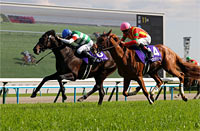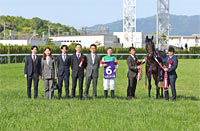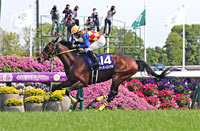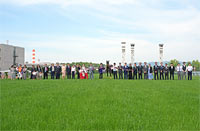Tenno Sho (Spring) (G1) - Data Analysis
Contest for spring emperor’s prize to be held at the renovated Kyoto Racecourse
After more than two years of suspension from holding race meetings, the Kyoto Racecourse held its grand reopening on April 22. The first G1 race to be held at the renovated venue will be the 167th Tenno Sho (Spring). This race, which is steeped in tradition, brings together stayers that excel in long distances. Let’s now look for some trends based on results over the last 10 years, including in the races held at Hanshin Racecourse in 2021 and 2022.
Contest between highly favored runners
While the Tenno Sho (Spring) has seen major upsets in the past, it has mostly unfolded in line with expectations in recent years, with Quinella bets only yielding a five-figure payout once in the last 10 years. All winners were backed as 4th favorite or higher, and there was a significant gap in Top 2 and Top 3 ratios between runners backed as 4th favorite or higher and those backed as 5th favorite or lower. It would therefore seem prudent to focus on runners that are backed as 4th favorite or higher. [Table 1]
[Table 1] Performance by favoritism (last 10 years)
| Favoritism |
Performance
[1st-2nd-3rd-4th or lower] |
Win ratio |
Top 2 ratio |
Top 3 ratio |
| 4th favorite or higher |
10-6-6-18 |
25.0% |
40.0% |
55.0% |
| 5th favorite or lower |
0-4-4-119 |
0% |
3.1% |
6.3% |
Top 4 finish in previous race is a good selection criterion
Success ratios diverged considerably between runners that finished in the Top 4 of their previous race and those that were beaten to 5th or lower. In recent years, there have been some examples of highly favored runners failing to live up to expectations, such as 2nd favorite Aristoteles finishing 4th in 2021 (previous race: Hanshin Daishoten, 7th) and 3rd favorite Kiseki finishing 6th in 2020 (previous race: Hanshin Daishoten, 7th). For this reason, a “Top 4 finish in the previous race” is likely to be a good selection criterion. [Table 2]
[Table 2] Performance by finish in previous race (last 10 years)
| Finish in previous race |
Performance
[1st-2nd-3rd-4th or lower] |
Win ratio |
Top 2 ratio |
Top 3 ratio |
| Top 4 |
9-8-10-75 |
8.8% |
16.7% |
26.5% |
| 5th or lower |
1-2-0-61 |
1.6% |
4.7% |
4.7% |
Only some prep races produce favorable race aptitude
The 30 Top 3 finishers over the last 10 years had contested one of the nine races shown in the table below in their previous race. Runners coming from the Nikkei Sho and the Hanshin Daishoten, which are major prep races, and the Osaka Hai (a middle-distance G1 race held as a G2 race until 2016) tend to perform well in the race. Runners that had triumphed in one of these three races have produced 11 Top 3 finishers, achieving a Top 3 ratio of over 50%. [Table 3]
[Table 3] Performance by major previous race (last 10 years)
| Previous races |
Performance
[1st-2nd-3rd-4th or lower] |
Win ratio |
Top 2 ratio |
Top 3 ratio |
| Nikkei Sho |
4-2-3-43 |
7.7% |
11.5% |
17.3% |
| Hanshin Daishoten |
2-4-4-47 |
3.5% |
10.5% |
17.5% |
| Osaka Hai |
2-1-0-6 |
22.2% |
33.3% |
33.3% |
| American Jockey Club Cup |
1-0-0-1 |
50.0% |
50.0% |
50.0% |
| Arima Kinen (The Grand Prix) |
1-0-0-0 |
100% |
100% |
100% |
| Diamond Stakes |
0-1-1-16 |
0% |
5.6% |
11.1% |
| Kyoto Kinen |
0-1-1-5 |
0% |
14.3% |
28.6% |
| Nikkei Shinshun Hai |
0-1-0-0 |
0% |
100% |
100% |
| Dubai World Cup |
0-0-1-1 |
0% |
0% |
50.0% |
Note: Includes years during which the Osaka Hai was held as a G2 race.
Note: Only includes races contested by Top 3 finishers.
Well-known jockeys have the upper hand
Seven jockeys have dominated the Tenno Sho (Spring) over the last 10 years. Six of these (excluding Kazuo Yokoyama) were veteran jockeys with a track record of 15 or more victories in JRA G1 races. It is often said that “jockeys determine the outcome of long-distance races,” so we should focus on jockeys who have racked up numerous wins in G1 races. Incidentally, seven currently active jockeys have secured 15 or more victories in JRA G1 races: Yutaka Take, Christophe Lemaire, Mirco Demuro, Kenichi Ikezoe, Norihiro Yokoyama, Yasunari Iwata, and Yuga Kawada. [Table 4]
[Table 4] Performance by major jockey in previous race (last 10 years)
| Jockey |
Performance
[1st-2nd-3rd-4th or lower] |
Win ratio |
Top 2 ratio |
Top 3 ratio |
| Yutaka Take |
2-1-0-5 |
25.0% |
37.5% |
37.5% |
| Masayoshi Ebina |
2-0-1-4 |
28.6% |
28.6% |
42.9% |
| Christophe Lemaire |
2-0-1-5 |
25.0% |
25.0% |
37.5% |
| Yuichi Fukunaga |
1-1-1-5 |
12.5% |
25.0% |
37.5% |
| Norihiro Yokoyama |
1-0-1-4 |
16.7% |
16.7% |
33.3% |
| Yasunari Iwata |
1-0-0-5 |
16.7% |
16.7% |
16.7% |
| Kazuo Yokoyama |
1-0-0-1 |
50.0% |
50.0% |
50.0% |
Note: Only includes jockeys who have secured victories over the last 10 years.
Check runners sired by Stay Gold, Deep Impact and Heart’s Cry
Only six sires have produced Top 2 finishers in the Tenno Sho (Spring) over the last 10 years. This suggests that a strong performance in the longest race (3,200m) in domestic G1 flat racing also hinges on a boost from pedigree. We should therefore check runners sired by Stay Gold, Deep Impact, and Heart’s Cry, who have produced numerous Top 3 finishers. [Table 5]
[Table 5] Performance by major sire (last 10 years)
| Sire |
Performance
[1st-2nd-3rd-4th or lower] |
Win ratio |
Top 2 ratio |
Top 3 ratio |
| Stay Gold |
4-1-1-11 |
23.5% |
29.4% |
35.3% |
| Deep Impact |
3-2-2-20 |
11.1% |
18.5% |
25.9% |
| Black Tide |
2-0-0-0 |
100% |
100% |
100% |
| Duramente |
1-0-0-0 |
100% |
100% |
100% |
| Heart’s Cry |
0-5-2-16 |
0% |
21.7% |
30.4% |
| Kizuna |
0-2-0-0 |
0% |
100% |
100% |
Note: Only includes sires that have produced Top 2 finishers over the last 10 years.
Seek out the winner!
Many victories by previous Kikuka Sho (Japanese St. Leger) winners
Runners that had previously enjoyed success in the Kikuka Sho (Japanese St. Leger) at the age of 3 have consistently triumphed in the Tenno Sho (Spring). As shown in the table below, seven of the eight winners since 2015 had previously won the Kikuka Sho, while the remaining winner had finished as runner-up in the same race. In other words, runners that have demonstrated their aptitude for long-distance races in the Kikuka Sho, which is the longest Classic race (3,000m), appear to be strong win contenders for the Tenno Sho (Spring). [Table 6]
[Table 6] Winners’ finish in Kikuka Sho (Japanese St. Leger) (last eight years)
| Year |
Winner |
Finish in Kikuka Sho (Japanese St. Leger) |
| 2015 |
Gold Ship |
1st |
| 2016 |
Kitasan Black |
1st |
| 2017 |
Kitasan Black |
1st |
| 2018 |
Rainbow Line |
2nd |
| 2019 |
Fierement |
1st |
| 2020 |
Fierement |
1st |
| 2021 |
World Premiere |
1st |
| 2022 |
Titleholder |
1st |
(Yodohito Himezono)
|



















